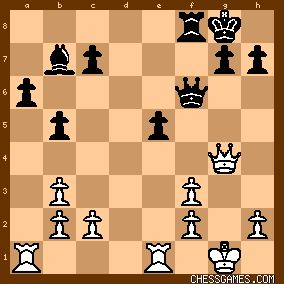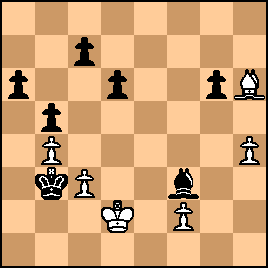| Oct-08-15 | | DrGridlock: Before computers, just about anything a grandmaster wrote was accepted as deeply insightful. In this game, Yusupov commented after 18 Nxf3+ At this point I took rather a fainthearted decision - to head for an ending a pawn up, which I was not certain to win. I should of course have carried on with the attack, but unfortunately I miscalculated. It seemed to me that the position after 18 ... Rf8 19 Bxe5 dxe5 20 Qd4 was not entirely clear. But by looking just a little further I could have reached the opposite conclusion: 20 ... Qg5+ 21 Qg4 Qf6, and Black has a fearsome attack. I am afraid the game continuation was much more prosaic. Analysis by Komodo finds that Black's attack is not so "fearsome": 
click for larger view1. ± (0.90): 22.Qg3 h5 23.Re3 h4 24.Qxe5 Qg6+ 25.Kf1 Qxc2 26.Qe6+ Kh7 27.Qg4 Qxb2 28.Rd1 Kg8 29.Qe6+ Kh7 30.Qe7 Qf6 31.Qxf6 Rxf6 32.Ke2 Rf7 33.Rd4 g5 34.b4 Kg6 35.Rd8 and that in fact, Black has thrown away his positional advantage so that it is White who now has the significant winning chances. As a personal observation, it seems that most GM analysis mistakes vs computer analysis seem to over-state the "fearsomeness" of an attack, and do not find a defensive resource that computers seem to find. |
|
Oct-08-15
 | | Gypsy: <... As a personal observation, it seems that most GM analysis mistakes vs computer analysis seem to over-state the "fearsomeness" of an attack, and do not find a defensive resource that computers seem to find.> Thx! |
|
Oct-08-15
 | | keypusher: <Dr Gridlock
As a personal observation, it seems that most GM analysis mistakes vs computer analysis seem to over-state the "fearsomeness" of an attack, and do not find a defensive resource that computers seem to find.> On the other hand, just because a computer thinks an attack isn't fearsome doesn't mean that a human being won't be scared, and rightly. Computers don't get nervous, they're not bothered by defending difficult positions under constant threat of mate, and they don't make trivial tactical oversights, so of course they are great defenders. Humans, even grandmasters, generally aren't like that. |
|
Oct-08-15
 | | perfidious: <DrGridlock: Before computers, just about anything a grandmaster wrote was accepted as deeply insightful....> Sure--by those who cannot, or will not, think for themselves. The ability to think critically is a vital trait, and not only in chess. |
|
| Oct-08-15 | | DrGridlock: <The ability to think critically is a vital trait, and not only in chess.> We're in agreement on that point.
Who has thought more critically:
- One who makes a sweeping judgment that, "Black has a fearsome attack"
or
- One who examines the concrete lines in a particular position to determine whether an attack breaks through or does not? Think critically before you reply :) |
|
Oct-08-15
 | | perfidious: Looks pretty fearsome to me. (laughs) |
|
| May-23-19 | | tigreton: One thing is certain: Yusupov's play was better than his own analysis. That means that the human being often shows his best during the game, because of the concentration, intuition, etc, that it involves. |
|
| May-23-19 | | SChesshevsky: Of course computers now find incredible defensive resources but only because they see just about all of the outcomes. With humans judgement is the key. Here the main thing is that Yusupov saw that 20. Qd4 line was unclear. He knows he has initiative but he is down the exchange. Without quickly seeing some sort of knockout blow or way to gain material, I'd be surprised if any GM would consider it enough to go another 25 moves deep. There is also judgement needed in reading GM notes, separating hyperbole from analysis. If Yusupov really saw anything out of the line, he probably would have demonstrated some conclusive moves and a more tangible evaluation than just "fearsome..." . Interestingly, on the CG computer at least, it appears that 20...Qg5 does lose most initiative but 20...Qf6 keeps some pull. |
|
May-23-19
 | | beatgiant: What's going on in the final position? Black has <37...Kd1> with zugzwang, and White's counterattack fails after 38. f5 gxf5 39. h5 f4+ 40. Kxf4 Kxd2 41. h6 <Bd3>, stopping the pawn? |
|
| May-24-19 | | Retireborn: <beatgiant> In Informator, Yusupov gives 37...Kd1 as actually played and calls it Zugzwang. Doesn't give a variation. |
|
May-15-24
 | | keypusher: SF confirms that the bishop of opposite colors ending is a draw. The key point comes after 32....Kb3.
click for larger viewNow 33.Bf8 would stop the advance of the pawns. (33.Bf4 is not as good, since after some maneuvering Black can play ...d5, Bxc7, ...d4, cxd4, ...Kxb4 with connected passed pawns.) After Spassky's 33.Kd3, ...c5 would have won, e.g. 34.Bd2 Bg4 35.Be1 d5! 36.Bd2 Bf5+ 37.Ke3 d4+ 38.cxd4 cxb4, or 34.Bf8 cxb4 35.cxb4 Kxb4 36.Bxd6+ Ka4 and again Black has connected passed pawns. Jussupow's 33....Bd5 gave Spassky one more chance to play Bf8, but instead 34.Kd4 was losing after 34....Bc4. Now Bf8 doesn't work any more: 35....c5+! 36.bxc5 dxc5+ 37.Bxc5 a5 and the a-pawn will cost a bishop, and ultimately White will lose his c-pawn as well, e.g. 38.f4 a4 39.Ke5 a3 40.Bxa3 Kxa3 41.Kf6 Bd3 42.Ke5 Kb3 43.Kd4 Bc4, zugzwang. Incidentally, Mihail Marin presents Jussupow's play in the opening of this game as a model against Spassky's 5.Nc3 in <A Spanish Repertoire for Black>. Spassky fared a lot better in Spassky vs A Beliavsky, 1988. |
|
| May-15-24 | | Retireborn: <keypusher> Worth pointing out that Yusupov's Informator score gives 33.Ke3? as played, so 33...Bd5 is forced then. |
|
May-15-24
 | | keypusher: <Retireborn: <keypusher> Worth pointing out that Yusupov's Informator score gives 33.Ke3? as played, so 33...Bd5 is forced then.> Oh, that makes sense. I wonder what the source of the current score is, but I would think the winner's notes would be pretty authoritative. I'll submit a correction slip. |
|
|
|
|





































